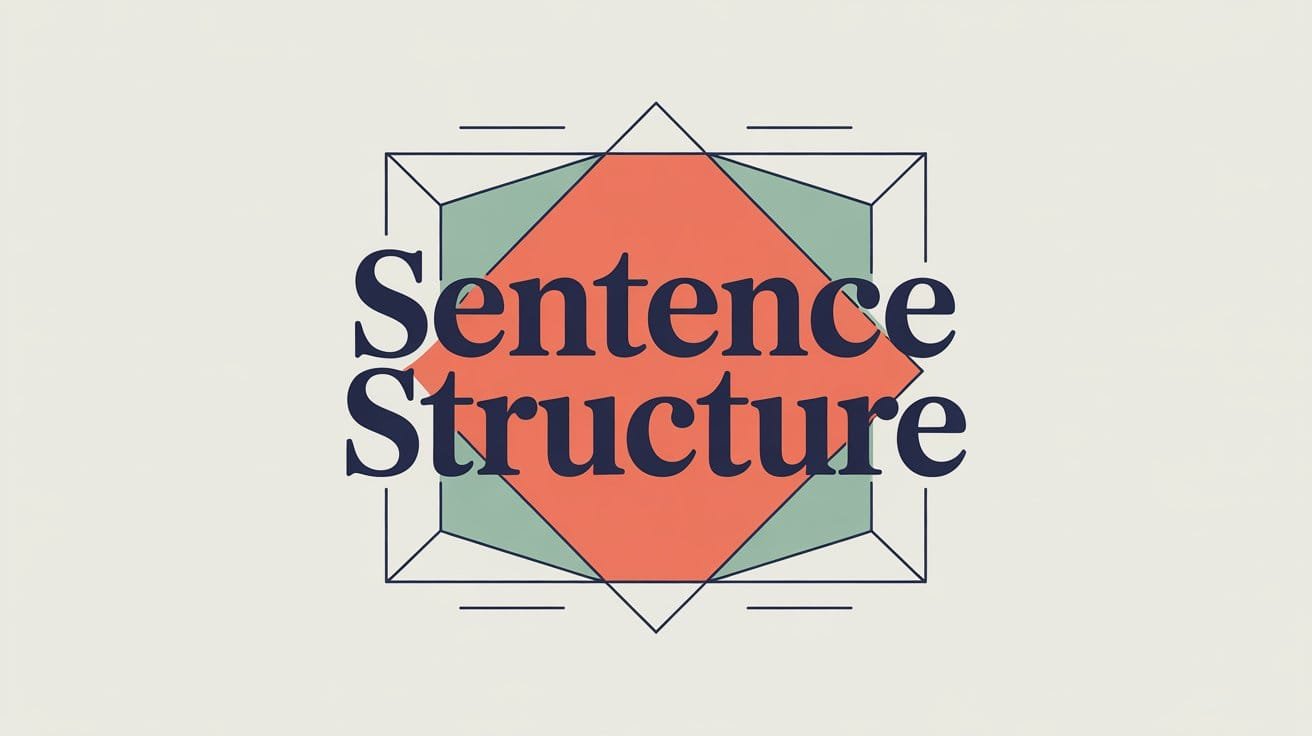Sentence structure refers to the way words are arranged to form clear and meaningful sentences. The order of subjects, verbs, and objects affects how easily your ideas are understood. When sentence structure is used well, your writing feels natural and organized.
In English grammar, there are four main sentence structures: simple, compound, complex, and compound-complex. Each one serves a different purpose. In this article, you’ll learn what sentence structure means, how to recognize each type, and how to use them to strengthen your writing.
Basic Components of a Sentence
Before exploring the four sentence structures, it’s important to understand the parts that make up a sentence. Every complete sentence in English includes at least a subject and a predicate, but strong writing often uses additional components to express complex ideas.
1. Subject
The subject tells us who or what the sentence is about.
- The cat slept.
- My friends and I ordered lunch.
2. Predicate
The predicate shows what the subject is doing or what condition it’s in. It always contains a verb.
- The cat slept.
- My friends and I ordered lunch.
3. Objects
Objects receive the action of the verb.
- Direct object: She built a treehouse.
- Indirect object: She gave her brother the last cookie.
4. Complements
Complements add meaning to the subject or object.
- Subject complement: The food smells delicious.
- Object complement: They made the room bright.
5. Modifiers
Modifiers add detail and description. These include adjectives, adverbs, and phrases.
- The small child laughed loudly in the hallway.
(“Small” modifies “child,” “loudly” modifies “laughed,” and “in the hallway” tells us where.)
6. Conjunctions
Conjunctions connect words, phrases, or clauses. They are essential for forming compound and complex sentences.
- Coordinating conjunctions (FANBOYS): for, and, nor, but, or, yet, so
- Subordinating conjunctions: although, because, if, when, since, etc.
- Correlative conjunctions: either…or, not only…but also
Example: I wanted to go for a walk, but it started raining.
7. Punctuation
Punctuation helps organize sentence elements and avoid confusion. It becomes especially important in compound and complex sentences.
- Commas are often used to separate clauses or items in a list.
- Semicolons can connect closely related independent clauses.
- Periods end a complete thought.
Example: She packed her bag, grabbed her keys, and left.
The Four Types of Sentence Structures
English sentences come in four main types, each defined by the number and type of clauses they contain. Understanding how these structures work gives you more control over your writing style and sentence variety.
1. Simple Sentence
A simple sentence contains one independent clause. It expresses a complete thought and has a subject and a verb.
- Mia studies every evening.
- The sun set behind the hills.
It may include modifiers, objects, or phrases—but it still counts as simple if there’s only one clause.
2. Compound Sentence
A compound sentence contains two or more independent clauses joined by a coordinating conjunction (such as and, but, or so) or a semicolon.
- I made tea, and she opened the windows.
- The movie started late; we missed the first scene.
Each part could stand alone as a sentence, but they are linked to show related ideas.
3. Complex Sentence
A complex sentence contains one independent clause and at least one dependent clause. The dependent clause cannot stand alone.
- Although it was raining, we went for a walk.
- She smiled because the message made her laugh.
These sentences often use subordinating conjunctions like because, although, when, or if.
4. Compound-Complex Sentence
This structure combines both compound and complex features. It contains at least two independent clauses and at least one dependent clause.
- While I was getting dressed, the phone rang, and the cat knocked over a vase.
- He likes to hike, and she enjoys cycling, although the weather hasn’t been great.
These are the most advanced sentence types, but with practice, they can add clarity and variety to your writing.
Sentence Patterns in English
Beyond sentence types, English follows common sentence patterns that describe how the subject, verb, and other parts are arranged. These patterns help explain how sentences are built from the ground up.
1. Subject + Verb (S-V)
This is the simplest sentence pattern.
- Birds fly.
- The phone rang.
2. Subject + Verb + Object (S-V-O)
The subject performs an action, and the object receives it.
- She wrote a letter.
- They play football.
3. Subject + Verb + Complement (S-V-C)
The complement gives more information about the subject, often through linking verbs like be, seem, or become.
- The soup tastes salty.
- He is an engineer.
4. Subject + Verb + Indirect Object + Direct Object (S-V-IO-DO)
The indirect object is the recipient of the direct object.
- She gave her friend a gift.
- They sent the teacher an email.
5. Subject + Verb + Object + Complement (S-V-O-C)
The object complement gives more detail about the direct object.
- They named the puppy Max.
- She found the lecture boring.
These patterns form the foundation of sentence construction in English. Knowing how they work helps you spot errors, improve clarity, and write more confidently.
Importance of Varying Sentence Structure
Using the same sentence structure over and over can make your writing feel repetitive and dull. Varying your sentence types and patterns helps keep your writing interesting, clear, and easier to read.
Why sentence variety matters:
1. Improves Flow
Mixing short and long sentences creates a rhythm that holds the reader’s attention.
- Too many short sentences: The sky was dark. It started to rain. We ran inside.
- With variation: The sky darkened, and as the rain began to fall, we ran inside for cover.
2. Adds Emphasis
A well-placed short sentence can stand out in a paragraph of longer ones.
- After a long buildup: And then it happened. Silence.
3. Increases Clarity
Different sentence structures help express complex ideas without confusion.
- A mix of compound and complex sentences can break up heavy information and improve understanding.
4. Makes Writing Sound More Natural
Natural speech doesn’t follow one fixed pattern. Using different structures helps your writing sound more like real communication.
In both academic and everyday writing, sentence variety makes your message stronger and more engaging.
Common Mistakes and How to Avoid Them
Understanding sentence structure also means learning how to avoid common errors that weaken clarity. Here are three of the most frequent sentence structure mistakes, along with how to fix them.
Run-on Sentences
A run-on sentence joins two or more independent clauses without proper punctuation or a conjunction.
Incorrect: We left the house it was already raining.
Correct: We left the house because it was already raining.
Correct: We left the house. It was already raining.
Correct: We left the house, and it was already raining.
Sentence Fragments
A fragment is a group of words that lacks a subject, a verb, or a complete thought.
Incorrect: Even though I called.
Correct: Even though I called, no one answered.
Comma Splices
This happens when two independent clauses are joined with only a comma.
Incorrect: She loves coffee, she drinks it every morning.
Correct: She loves coffee, and she drinks it every morning.
Correct: She loves coffee. She drinks it every morning.
Correct: She loves coffee; she drinks it every morning.
To avoid these mistakes, read your writing carefully, and check whether each sentence has a complete idea and correct punctuation.
FAQs
What is sentence structure in English?
Sentence structure refers to how words are arranged in a sentence, including the order of the subject, verb, and other elements. It affects how clearly and effectively a sentence communicates an idea.
How do you identify different sentence structures?
Start by identifying the number and type of clauses.
One independent clause = simple sentence
Two or more independent clauses = compound sentence
One independent + one or more dependent clauses = complex sentence
A mix of all = compound-complex sentence
Why is it important to vary sentence structure?
Varying sentence structure keeps writing clear, natural, and engaging. It helps avoid repetition, emphasizes key ideas, and improves overall readability.
What are common sentence structure errors?
Common mistakes include run-on sentences, sentence fragments, and comma splices. These happen when clauses are connected incorrectly or incomplete ideas are presented as full sentences.
How can I improve my sentence structure in writing?
Practice identifying sentence types and patterns in your own writing. Read aloud to check flow, and revise sentences that feel repetitive or unclear. Learning how clauses and punctuation work will also help.



